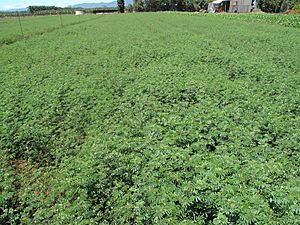Desmanthus virgatus facts for kids
Quick facts for kids Desmanthus virgatus |
|
|---|---|
 |
|
| Cultivated | |
| Conservation status | |
| Scientific classification | |
| Kingdom: | |
| (unranked): | |
| (unranked): | |
| (unranked): | |
| Order: | |
| Family: | |
| Genus: |
Desmanthus
|
| Species: |
D. virgatus
|
| Binomial name | |
| Desmanthus virgatus (L.) Willd.
|
|
| Synonyms | |
|
Acacia angustisiliqua |
|
Desmanthus virgatus is a type of flowering plant. It belongs to the legume family, just like peas and beans. This plant has many common names. Some of these are wild tantan and dwarf koa. It is originally from warm, tropical parts of America. But you can now find it in many other places too. People sometimes grow it to feed farm animals. It is a good plant for fodder (food for animals) and forage (plants animals eat while grazing).
Contents
What is Desmanthus virgatus?
This plant is a woody herb or shrub. It can grow up to 1.5 to 3 meters (about 5 to 10 feet) tall. During dry times, the plant's green parts may die back. But its woody taproot (main root) stays alive. When it rains again, new shoots grow from the root. One plant can grow up to 50 stems. These stems can become very strong. Older stems are usually brown or red. They are also shiny and smooth.
Leaves and Flowers
The leaves of Desmanthus virgatus are special. They are called bipinnate. This means they are divided into smaller leaflets. These leaflets are only about 7 to 9 millimeters long. The plant's flowers grow in a cluster. This cluster is called an inflorescence. Each cluster can have up to 22 flowers. The flowers are white to yellowish in color. Some flowers are perfect (have both male and female parts). Others are only male or sterile (cannot produce seeds).
Fruits and Seeds
After flowering, the plant grows fruit pods. These pods are long and thin. They can be up to 9 centimeters (about 3.5 inches) long. The pods are dark red to blackish. When they are ripe, they open along their edges. This releases the seeds. Each pod can hold up to 30 seeds. In tropical places with enough water, the plant grows flowers and fruits all year. In other areas, it mainly reproduces in spring and summer.
Where Does Desmanthus virgatus Grow?
This plant likes to grow in open areas. It can easily grow in places that have been disturbed. This includes roadsides and quarries (places where stone is dug out). It grows well in both clay and sandy soils. You will find it most often at lower altitudes (closer to sea level).
Surviving Tough Conditions
Desmanthus virgatus is very tough. It can survive dry weather, frost, fire, and animals eating it. This is because it can die back to its root crown. Then, it grows back when conditions get better. However, it does not like shade. It cannot grow well under a tree canopy.
Native and Introduced Areas
This plant is native to many parts of the Americas. This includes the southern United States, parts of Mexico, Central America, South America, and the Caribbean. It has also been brought to other places. Sometimes this was on purpose, and sometimes by accident. In the United States, it is native to Texas. It also grows in Florida. It was first seen in Louisiana in 2011. It is now found in several African countries. These include Senegal, Zambia, and South Africa. It also grows on Pacific Islands like New Caledonia and Hawaii. You can also find it in Indonesia, the Philippines, India, and Australia. In some of these places, people consider it a weed.
How is Desmanthus virgatus Used?
The prostrate bundleflower is a good plant for farm animals. It is safe for them to eat. It also has a lot of protein. Studies have shown it helps cows gain weight. So, it is a good food source for cattle. However, it is not as good for pigs.
Benefits for Soil
This plant also helps the environment. It can help stop erosion (when soil is washed away). It also helps with nitrogen fixation. This means it takes nitrogen from the air and puts it into the soil. This makes the soil healthier.
Grazing and Cultivation
Farmers can cut this plant to feed animals. Or, they can let animals graze directly in the field. The plant is very good at handling grazing. In fact, animals eating it can actually help the plant grow more. It also helps more young plants survive. Animals like sheep help spread the plant's seeds. The seeds can pass through their bodies and still grow. Several special types of this plant have been created for farming. These are called cultivars. Two examples are 'Marc' and 'Balli Germplasm'.
How Scientists Classify Desmanthus virgatus
Sometimes, scientists think of D. virgata as a "species complex." This means it might include a few very similar types of plants. These include Desmanthus acuminatus, D. paspalaceus, and D. tatuhyensis. In the past, many scientists grouped other Desmanthus plants under the name D. virgata. These included D. pubescens, D. pernambucanus, D. glandulosus and D. leptophyllus. But now, they are usually seen as separate species.
See also
 In Spanish: Bilil para niños
In Spanish: Bilil para niños


